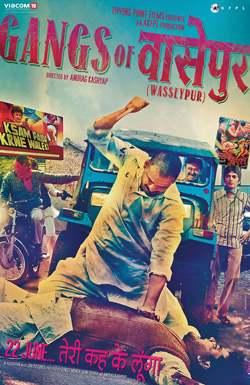Dhanbad’s coal mafia is notorious for its violence. But in Gangs of Wasseypur, Anurag Kashyap has dug deep for another precious resource — rich language
By Amitava Kumar
 |
Amitava Kumar
Photo: Shailendra Pandey |
 |
On a recent Sunday, I took the Metro North to Grand Central Station; stepped out into the warm afternoon air, and after walking for less than 10 minutes, entered a dark night in Bihar.
A van was driving through a narrow alley in a small town. Men carrying automatic weapons got out and shouted to shop-owners to bring down their shutters. Arriving at a door, they began to fire. The attackers, several clad in kurtas, threw bombs inside. Then they fired more shots.
What impressed me most was not the indiscriminate shooting — irresponsible in its profligacy — but the general lack of personal safety displayed by the shooters. This was not so much a shooting raid as much as a macho staging of rangdaari. I was familiar with this attitude of casual disregard, what managerial pundits would call a lack of professionalism, and it pleased me. On the closing night of the New York Indian Film Festival, in the Greenwich Village theatre where Anurag Kashyap’s Gangs of Wasseypur was being screened, I suddenly felt that I had come home.
The assault continued at close range. A few family members were hiding in a room. The leader of the attackers made a call from his cell phone. A phone rang inside. The ringtone was from a Sanjay Dutt starrer, “Nayak nahin, khalnayak hoon main.” No one answered. The leader of the attackers assumed that everyone had been killed. He now called his employer. “Gaya Faizal Bhitrampur” (Faizal is now dead).
The familiar idiomatic description thrilled me. This is what I had come to experience in the theatre that day. Hindi not as spoken by the airhostesses on the flight from Delhi to Patna but the colourful argot of the street. Language as hot vernacular.
This feeling only grew later in the film with the song Teri keh ke lunga. Written by the brilliantly gifted Piyush Mishra, the song posed a challenge. Sneha Khanwalkar’s voice — the voice of a female singing the flagrant opening lines — was provocation enough. Ras bheege saude ka ye/Khooni anjaam/Teri keh ke lunga /Teri keh ke lunga. Bold and incendiary. But after a minute or so, I began to attend to the subtitles. In the dark, I wrote down in my notebook what I was reading on the screen: “You’ll know my name when I fuck you dry… Ain’t I nice, I just fucked you twice.”
Such audacity! Such a willingness to speak the language of damaged desire! The filmmaker as a gangster!
Sure Kashyap is bold in his grasp of the language of cinema. Even his film’s title pays homage to Martin Scorsese; there is a similar debt to Coppola’s The Godfather and Tarantino’s Pulp Fiction. But I’m not impressed by that easy trafficking of images. I’m even less impressed by Kashyap’s ambition to tell an epic tale going back to the days of the British when coal was first found. History can be left quite safely to the historians. Art need not explain in order to enlighten or even to entertain.
But language is another matter. It is the film’s real triumph. Let me translate what a butcher wearing a ganji tells a rookie policeman: “This is Wasseypur. Here even a pigeon flies with only one wing, and with the other it tries to protect its honour.”
That is what all that shooting comes down to. The desperate drive to find protection against shame. The shame of knowing that you are fucked. You are either singing “Teri keh ke lunga” — or what is more likely for most people, you are being sung to. Humiliation is par for the course. If you are a star, you will slap a friend in public. But if you are a nobody, you’ll only want to save your ass. In your dreams, you’ll itch to pull the trigger. Of course, revenge is short-lived while death lasts forever, but that brief, bright moment when you challenge fate is worth the dying. O jiya ho Bihar ke lala, arrey jiya tu hazaar saala.
letters@tehelka.com |

